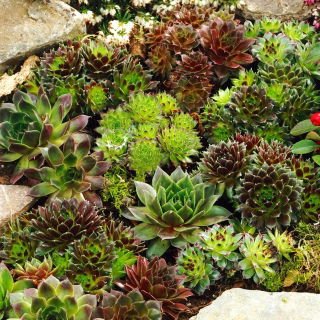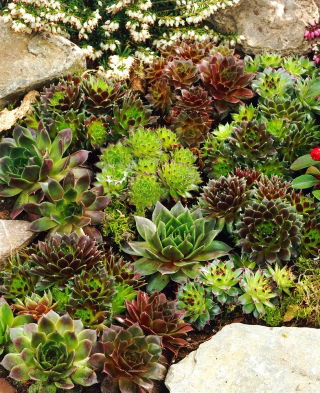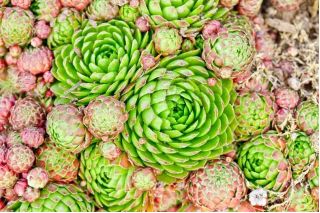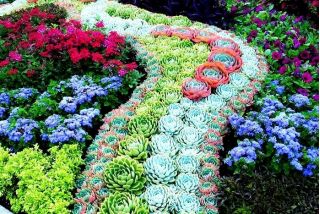Houseleeks, also known as Sempervivum, are perennial plants that bring a unique charm to any garden. With their fleshy leaves arranged in rosettes, these low-growing clumps, ranging from 5 to 20 cm in height, are an ideal choice for rock gardens, walls, slopes, and containers. The splendid variety of rosette colours and shapes makes houseleeks a perfect ornamental addition throughout the season. They are highly popular due to their ease of cultivation and resilience in challenging conditions.
Sowing
Houseleeks are best sown in well-drained soil, providing optimal conditions for seed germination. Place the seeds directly on the soil surface, gently pressing them to ensure proper contact with the substrate. It is advisable to avoid over-sowing, which may affect their germination ability.
Sowing Depth
Seeds are best placed at a depth of approximately 0.3 cm. This depth offers suitable conditions for growth while protecting them from drying out and adverse external conditions. A light covering of soil helps maintain moisture and supports the germination process.
Direct Sowing Period
Houseleeks can be directly sown in the garden during the warmer months when the risk of frost has passed, typically from May to June.
Sowing Period Under Cover
For sowing under cover, the best period is early spring, from March to April. During this time, light conditions and temperature are conducive to rapid germination and healthy growth of young plants.
Planting Time
Houseleeks are best planted in their permanent garden location from May to June. During this time, the plants are well-rooted and ready to thrive for the rest of the season. Planting at the right time helps avoid frost damage to young seedlings.
Plant Spacing
When planting houseleeks, maintain a spacing of 10-8 cm. This distance allows the plants to develop freely and ensures adequate air circulation, minimizing the risk of fungal diseases.
Companion Planting
Houseleeks pair excellently with other rock garden plants, such as sedums and saxifrages. Their diversity in colour and structure harmonizes beautifully with other plants, creating a cohesive look. It's also beneficial to plant them alongside species with similar soil and light requirements to provide optimal growth conditions.
Site Conditions
Houseleeks prefer sunny spots, which enhance the vivid colouring of their leaves. The soil should be well-drained, ideally with a slightly acidic to neutral pH. Avoid waterlogged areas, as this can lead to plant rot. Houseleeks are incredibly drought-resistant, thriving well in dry and sandy soils.
Growing Tips
Growing houseleeks is straightforward and requires minimal effort. These plants are drought-resistant, making them an excellent choice for those with limited time for daily garden maintenance. Regular removal of spent flower stems supports their growth and aesthetics. In winter, protect them from excessive moisture, which can cause rosette rot.
Plant Height
Houseleeks form compact, low mounds ranging from 5 to 20 cm in height, making them an ideal choice for rock gardens, walls, and slopes. Their compact structure also makes them perfect for containers, where they can serve as attractive decorative elements.
Flowering Period
Houseleeks bloom from May to September, offering a wide range of flower colours and forms. Flowers appear on tall stems, adding extra charm and appeal to the plants. Their extended blooming period makes them an excellent choice for a garden that delights throughout the summer.
Usage
With their resilience and decorative appearance, houseleeks are ideal for rock gardens, walls, slopes, and containers. Their modest requirements mean they can be cultivated even in challenging conditions where other plants might not survive. They also perform well on green roofs, where their ability to withstand extreme conditions is invaluable.
Resistance to Diseases
Houseleeks are highly resistant to diseases, making them extremely easy to cultivate. Their fleshy leaves effectively protect against most pathogens, with excessive moisture being the only potential threat, leading to rosette rot. Regular removal of wilted leaves and flower stems helps maintain the plants in excellent condition.
Good to Know
Houseleeks are plants that can survive even in the most challenging conditions. Their name, Sempervivum, comes from the Latin expression "always alive," aptly describing their survival ability. Notably, houseleeks are also frost-resistant, making them an ideal choice for gardens located in cooler regions. These hardy plants will satisfy both beginner and experienced gardeners.
Why Buy from Garden Seeds Market
Purchasing houseleeks from Garden Seeds Market ensures the highest quality seeds. All products are carefully selected to guarantee excellent properties. With laboratory-tested seeds, Garden Seeds Market offers high germination rates, leading to successful cultivation. The store provides fast and reliable delivery, allowing you to enjoy your seeds in no time. The positive feedback from satisfied customers is the best testament to the reliability and professionalism of the services offered.
The seed packet contains 0.02 g of seeds. The package includes information on cultivation guidelines and the sowing expiry date.










